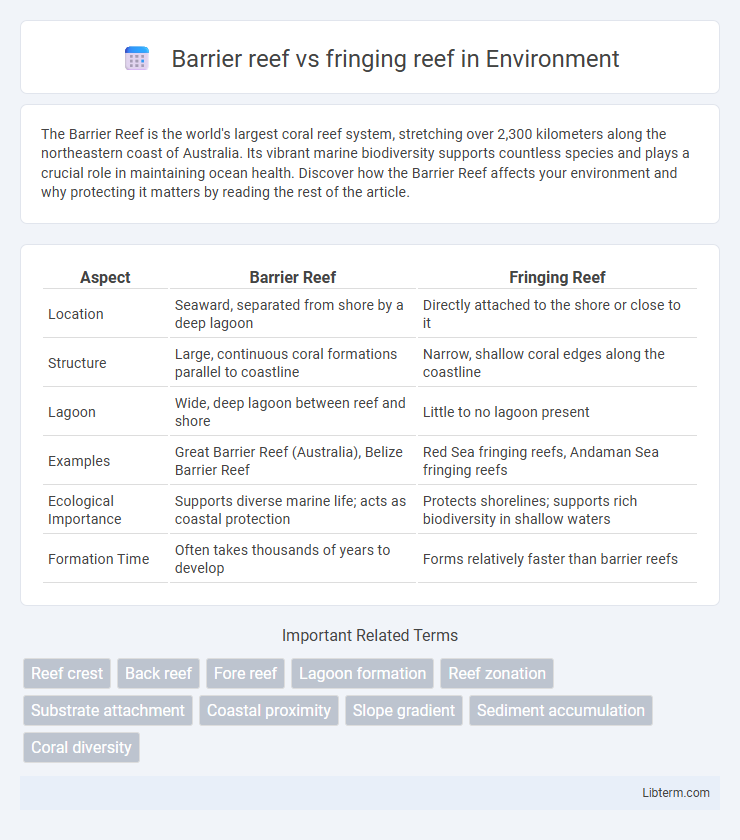The Barrier Reef is the world's largest coral reef system, stretching over 2,300 kilometers along the northeastern coast of Australia. Its vibrant marine biodiversity supports countless species and plays a crucial role in maintaining ocean health. Discover how the Barrier Reef affects your environment and why protecting it matters by reading the rest of the article.
Table of Comparison
| Aspect | Barrier Reef | Fringing Reef |
|---|---|---|
| Location | Seaward, separated from shore by a deep lagoon | Directly attached to the shore or close to it |
| Structure | Large, continuous coral formations parallel to coastline | Narrow, shallow coral edges along the coastline |
| Lagoon | Wide, deep lagoon between reef and shore | Little to no lagoon present |
| Examples | Great Barrier Reef (Australia), Belize Barrier Reef | Red Sea fringing reefs, Andaman Sea fringing reefs |
| Ecological Importance | Supports diverse marine life; acts as coastal protection | Protects shorelines; supports rich biodiversity in shallow waters |
| Formation Time | Often takes thousands of years to develop | Forms relatively faster than barrier reefs |
Introduction to Coral Reefs
Barrier reefs form parallel to the shoreline but are separated by deeper, wider lagoons, often stretching over vast lengths like the Great Barrier Reef in Australia. Fringing reefs, in contrast, grow directly adjacent to coastlines, creating narrow, shallow zones without significant lagoons. Both reef types serve as critical marine ecosystems, supporting biodiversity, coastal protection, and nutrient cycling in tropical ocean waters.
What are Barrier Reefs?
Barrier reefs are extensive coral formations that run parallel to coastlines but are separated by deep, wide lagoons, often several kilometers wide. These reefs develop on continental shelves, creating natural barriers that protect shorelines from waves and storms while supporting diverse marine ecosystems. The Great Barrier Reef in Australia exemplifies a barrier reef, showcasing vast biodiversity and significant ecological importance.
What are Fringing Reefs?
Fringing reefs are coral reef formations that develop directly along the coastline, closely attached to the shore with no significant lagoon separating them from the land. These reefs grow in shallow waters, providing critical habitats for diverse marine species and protecting shorelines from erosion. Unlike barrier reefs that form at a distance offshore separated by a deep lagoon, fringing reefs are the most common and accessible type of reef ecosystems worldwide.
Key Structural Differences
Barrier reefs are separated from the shore by a deep lagoon, often extending parallel to the coastline with significant water depth between the reef and land, while fringing reefs directly border the shore without a lagoon, growing close to the land with shallow waters. Barrier reefs typically exhibit more complex, mature structures with extensive reef flats and slopes, whereas fringing reefs have simpler formations with a gradual slope from the shoreline. The Great Barrier Reef exemplifies a barrier reef with its vast size and lagoon system, contrasting with the narrow, contiguous nature of fringing reefs found in places like the Red Sea.
Formation Processes
Barrier reefs form through the gradual subsidence of volcanic islands coupled with coral growth, creating a lagoon between the reef and the island, whereas fringing reefs develop directly along the shorelines of landmasses without such a lagoon. Coral polyps secrete calcium carbonate, building up structures over time that adapt to changes in sea level and substrate stability during these processes. The differing geological and hydrodynamic conditions influence the reef morphology and the ecological niches within barrier and fringing reefs.
Geographic Distribution
Barrier reefs primarily develop along coastlines separated from the shore by deep lagoons, commonly found in the Caribbean Sea, Great Barrier Reef of Australia, and parts of the Pacific Ocean. Fringing reefs grow directly adjacent to the shoreline, prevalent along the coastlines of the Red Sea, Indian Ocean, and smaller islands in the Indo-Pacific region. The spatial positioning of barrier reefs allows for larger reef systems, while fringing reefs form narrower ecosystems closely linked to terrestrial runoff and coastal sedimentation.
Biodiversity and Marine Life
Barrier reefs support extensive biodiversity by providing diverse habitats such as lagoons, deep channels, and coral cays, which host a wide array of marine species, including fish, mollusks, and corals. Fringing reefs, being directly attached to shorelines, foster rich marine life concentrated in shallow waters, including juvenile fish and invertebrates that rely on the reef for shelter and feeding grounds. Both reef types contribute significantly to marine ecosystem services, but barrier reefs often sustain more complex and varied biological communities due to their larger size and spatial separation from land-based influences.
Ecological Importance
Barrier reefs and fringing reefs both provide crucial habitats that support marine biodiversity, offering shelter and breeding grounds for numerous fish species and invertebrates. Barrier reefs, such as the Great Barrier Reef, act as natural barriers protecting coastlines from storm surges and erosion, while fringing reefs contribute to coastal stability and nutrient cycling in shallower waters. Both reef types play essential roles in maintaining the health of marine ecosystems and supporting fisheries important for local communities.
Threats and Conservation Challenges
Barrier reefs face significant threats from climate change-induced coral bleaching, ocean acidification, and coastal development, which compromise their structural integrity. Fringing reefs are particularly vulnerable to sedimentation, pollution from nearby land sources, and overfishing, leading to habitat degradation and loss of biodiversity. Conservation challenges for both reef types include implementing effective marine protected areas, controlling land-based pollution, and promoting sustainable tourism practices to preserve reef ecosystems.
Barrier Reefs vs Fringing Reefs: Summary Comparison
Barrier reefs form parallel to the shore but are separated by a deep lagoon, while fringing reefs develop directly along the coastline without a significant lagoon. Barrier reefs tend to be larger and more diverse in marine life due to greater water circulation and habitat variety, whereas fringing reefs are smaller and more vulnerable to coastal impacts. Both reef types play critical roles in coastal protection and biodiversity but differ significantly in structure, size, and ecological dynamics.
Barrier reef Infographic

 libterm.com
libterm.com